Do Hawks Eat Birds? Overview of Hawk Species, Hunting Techniques & Adaptations!
Hawks are opportunistic feeders. This means they often take advantage of any easy meal they locate, including an assortment of rodents. They also prey on various reptiles, amphibians, and small mammals like rabbits. But do hawks eat birds?
Yes, hawks eat many bird species, including pigeons and doves, because they are easy to catch and rich in essential nutrients like protein. They also eat game birds, waterfowl birds, passerines, and other raptors like owls. Typically, hawks eat birds as often as they can capture them and based on their availability.
So then, how often do hawks eat birds? Do hawks eat small birds, and what hunting techniques do they use to capture bird prey? In this article, we will answer all your queries regarding hawks and what birds they eat.
Types of Birds Consumed By Hawks
Hawks eat a wide range of bird species. However, the type of birds consumed by these raptors varies from one hawk species to another. So, what kind of birds do hawks eat? Let’s find out in the table below.
| Category of Bird Prey | Type of Bird Species |
| Passerines | Sparrows, finches, starlings, thrushes, jays, warblers, tits, and songbirds |
| Waterfowl | Ducks, geese, and swans |
| Game Birds | Quails, pheasants, wild turkeys, and grouse |
| Raptors | Small hawk species and weak, injured, or sick owls or fledgling owls |
| Columbidae | Pigeons and doves |
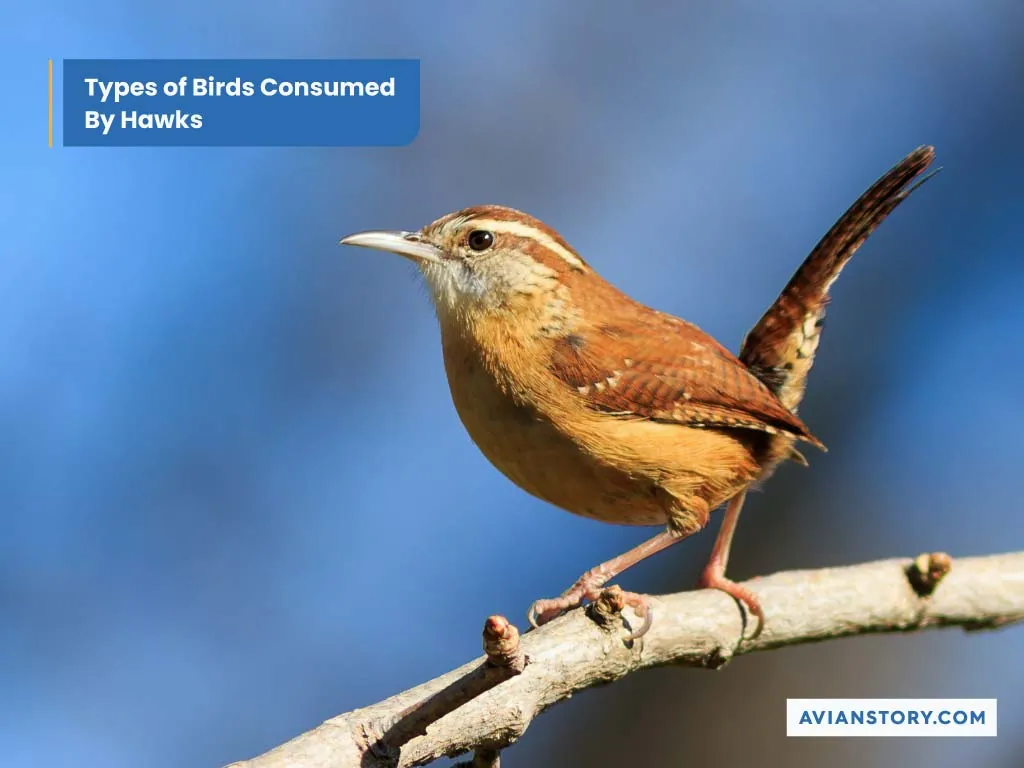
Now let’s discuss the kind of birds that hawks frequently prey on in the wild in detail.
Passerines
These are small to medium-sized birds, ranging from 3 to 46 inches long. Hawks are notorious for preying on Passerine birds, such as sparrows, starlings, finches, songbirds, thrushes, tits, jays, and warblers.
Because of their small size and availability in many habitats, these birds are an easy target for hawks. Besides, these birds are rich in essential nutrients. For instance, sparrow meat contains about 58% of protein and 42% of fat per 100 g.
Pigeons and Doves
These are common bird prey for many hawk species. This is because pigeons and doves are relatively slow-moving, especially when taking off. In addition, pigeons and doves have a reasonably high protein matter of about 24% per 100 g.
On top of that, they are found in many habitats, including arboreal forests, rainforests, and swamp forests. But do hawks eat birds alive? Yes. Hawks usually start eating pigeons, doves, and other birds on the spot while they are still alive.
Waterfowl
This is a diverse family of birds known to inhabit the tropics, the high Arctic, and the ocean. They are adapted to living in and around water bodies. Species like the goshawk and Cooper’s hawk are notorious for preying on waterfowl birds, such as ducks, geese, and swans.
This is because these birds are an excellent source of nutrients like protein, iron, and vitamin A. For instance, ducks contain about 33% of protein content per 85 g, while swans have around 38% per 100 g.
Game Birds
These are bird species hunted for food or sport. Hawks may hunt game birds such as quails, pheasants, and grouse. But do hawks eat turkeys? Yes. This is because these birds are found in many forests and open fields, which are typical hawk habitats. On top of that, turkey has about 24% protein matter per 85 g.
Raptors
Larger species of hawks, like the Cooper’s and goshawks sometimes prey on smaller raptors. They may prey on smaller hawk species like Merlins and American Kestrels.
Hawks may also go after sickly, weak, old, or injured owls and owlets. Owls contain about 45% protein matter, 27% of iron, and 7% of vitamin A per 100 g. Fledgling owls are also an easy catch for many hawk species. However, hawks don’t actively hunt owls.
Factors Affecting Hawks’ Bird Predation

The success of hawks bird predation may be affected by several factors, which include the following:
Habitat
Hawks prefer to hunt in open areas because such habitats make it easier to scout bird prey. These include open grasslands, deserts with few trees, or woodlands with scattered clearings.
Prey Abundance and Availability
Additionally, these predatory birds favor bird prey that is readily available in abundance. This is because prey abundance increases their predation success.
Seasonal Changes
During the winter, hawks may switch to other prey sources like small mammals and carrion because of bird scarcity. But during the fall and spring, when birds are migrating, hawks may hunt for them more actively.
Age and Experience
Older hawk species have more experience in hunting than their younger counterparts. Therefore, the older hawks are likely to be more successful in hunting for birds.
Hunting Techniques
Hawks use various techniques to capture bird prey. Some methods are more effective at catching birds than others. For example, ground hunting may not work well for catching birds, but aerial pursuit and perch hunting offer more success.
Overview of Hawk Species and Their Bird Prey
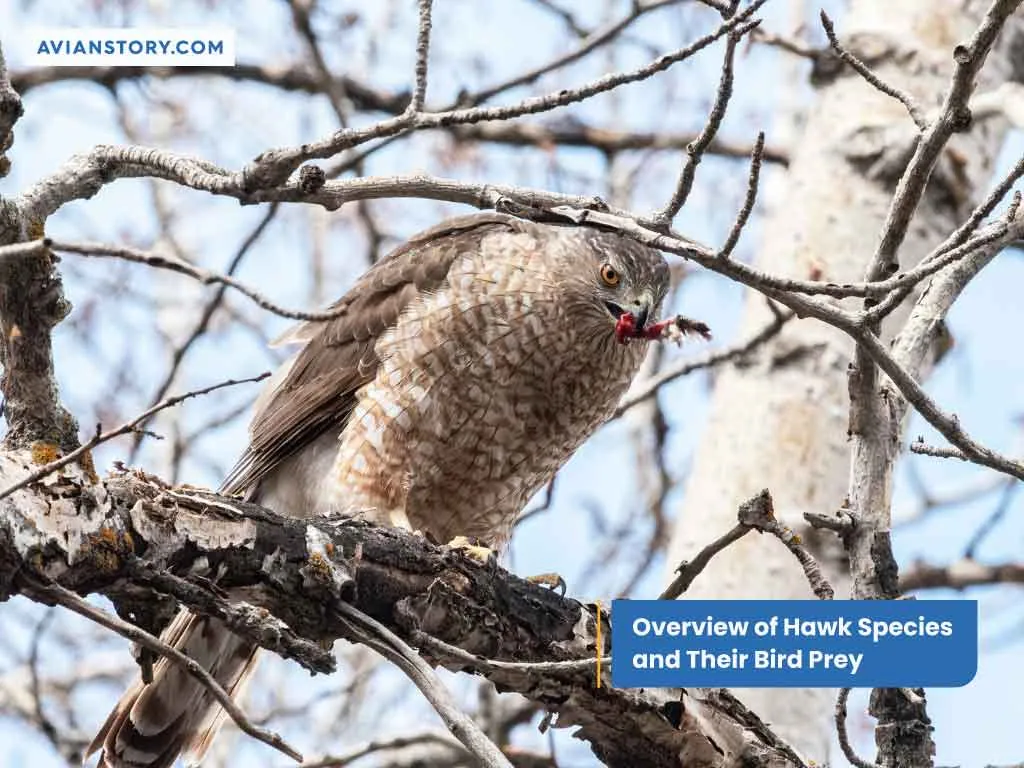
Hawks are a group of predatory birds in the family Accipitridae. Sometimes, the term hawk is extended to include particular members of the family Falconidae, which belong to the order Falconiformes. Below we will discuss the common hawk species and their bird prey.
Accipitridae family
The family Accipitridae comprises about 250 hawk species found in all parts of the world except Antarctica. These species are divided into several genera, including:
Accipiters
This genus includes 51 known hawk species and most are called sparrowhawks or goshawks. The following are the common species in this genus and their bird prey.
Goshawk
The northern goshawk, often referred to as the goshawk, is a medium-large bird commonly found in northern America and Eurasia. It is known to prey on medium-sized birds like wood pigeons and game birds like ducks, swans, wild turkeys, and peacocks. Members of the crow family (corvids) are also part of their predominant diet.
Cooper’s Hawk
This hawk species is native to North America, starting from Southern Canada to Northern Mexico. Like the goshawk, the Cooper’s hawk primarily feeds on medium-sized birds, especially passerines. These include flickers, robins, jays, starlings, and thrushes. It also preys on woodpeckers, doves, pigeons, red-winged blackbirds, and quails.
Sharp-shinned Hawk
You can find this hawk species throughout North, Central, and South America. The species is also native to a few Caribbean islands like Puerto Rico and Dominican Republic. Regarding bird prey, this predatory bird mainly eats small birds, such as finches, sparrows, wrens, nuthatches, wood-warblers, and icterids.
Buteos
Hawk species belonging to this genus are commonly referred to as soaring hawks because of their long and broad wings. The species include:
Red-tailed Hawk
This is one of the most common members within the genus Buteo, commonly found in North America. It is known to mainly prey on small mammals. So then, do red tailed hawks eat birds? Yes. This species often hunts birds as big as pheasants and chickens.
Red-shouldered Hawk
This is a medium-sized buteo known to inhabit the coastal regions of California and Northern, and Central Mexico. Its frequent prey includes feeders and common backyard birds, such as the house sparrows, mourning doves, and starlings.
Swainson’s Hawk
The Swainson’s hawk winters in South America, including Argentina, southern Brazil, and Paraguay. During the breeding season, the species can be found in the western United States and Canada. Its bird prey comprises small songbirds, quails, and doves.
Broad-winged Hawk
The broad-winged hawk has its distribution across North and South America, southern Brazil, and southern Canada. It is known to prey on nestling birds, like woodpeckers, thrushes, and warblers during the breeding season.
Harriers
The harries belong to the subfamily Circinae of the family Accipitridae. This subfamily comprises:
Northern Harrier
Also referred to as the ring-tailed or marsh hawk, this species breeds throughout the northern USA and Canada. This raptor constantly hunts birds, such as young waterfowl, small shorebirds, larks, sparrows, and pipits.
Falconidae Family
This family comprises several diurnal birds of prey closely related to hawks, including caracaras and falcons.
Falcons
This is one of the 60 species of hawks of the family Falconidae. Some common falcon birds include:
Peregrine Falcon
This bird is native to many oceanic islands across Asia, Europe, Africa, and America. Its primary diet comprises pigeons around cities. The Peregrine falcon also preys on shorebirds, gulls, grebes, ducks, songbirds, and numerous waterfowl.
American Kestrel
The American Kestrel is distributed in North America, from northern Canada to the tropics of Central America. It mostly feeds on small birds the size of quails, sparrows, and finches.
Merlin
This small but fierce falcon is found in North America, Asia, and Europe. It can feed on birds as large as pigeons and small-to-medium-sized songbirds. In the city, the Merlin chiefly hunts house sparrows, but during the winter, it preys on small shorebirds.
Hunting Techniques for Capturing Birds
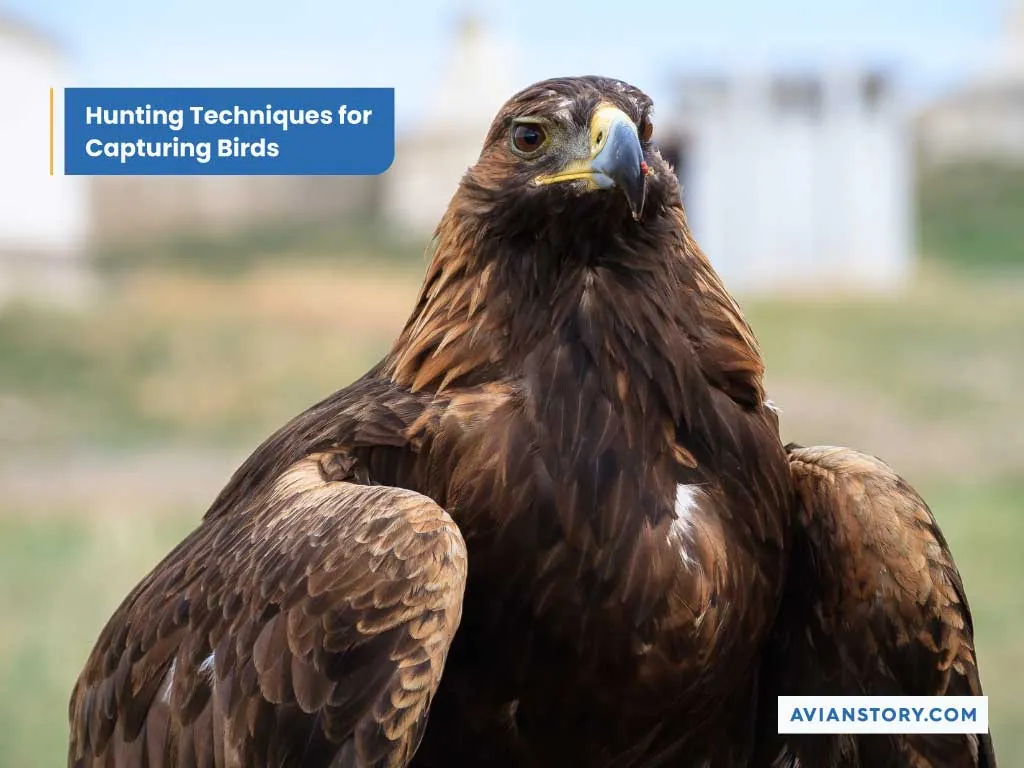
Hawks are among the most skilled predators and use different techniques to hunt for birds. These include:
Perch Hunting
Hawks often perch on a fence, lamppost, or in a tree while watching and waiting for potential bird prey to pass by. And once they spot the prey, they usually glide down toward it and grab it using their powerful talons.
Pursuit Through Vegetation
Certain hawk species like the Cooper, may fly low and fast via the vegetation while trying to spot potential prey. And once it sights the prey, the hawk usually pursues it through the dense vegetation. When it gets close enough to the prey, the hawk often makes sudden bursts of speed and lunges toward the bird to catch it.
Aerial Pursuit
Some species, such as the peregrine falcon, typically soar high to pursue their prey in flight. They take advantage of their speed and agility to capture bird prey in mid-air.
Cooperative Hunting
This technique is common among Harris’s hawks. These species usually hunt in groups. Simply, the hawks work together to drive out their prey from their hiding places. They then surround the prey and capture it.
Stooping and Talon Strikes
For this technique, the hawk usually flies high above the ground scouting for prey. Once it sights a target, it dives down toward the prey on a steep stoop. The hawk then extends its sharp talons and strikes the prey with immense force, and flies away with it.
Adaptations for Capturing and Consuming Birds
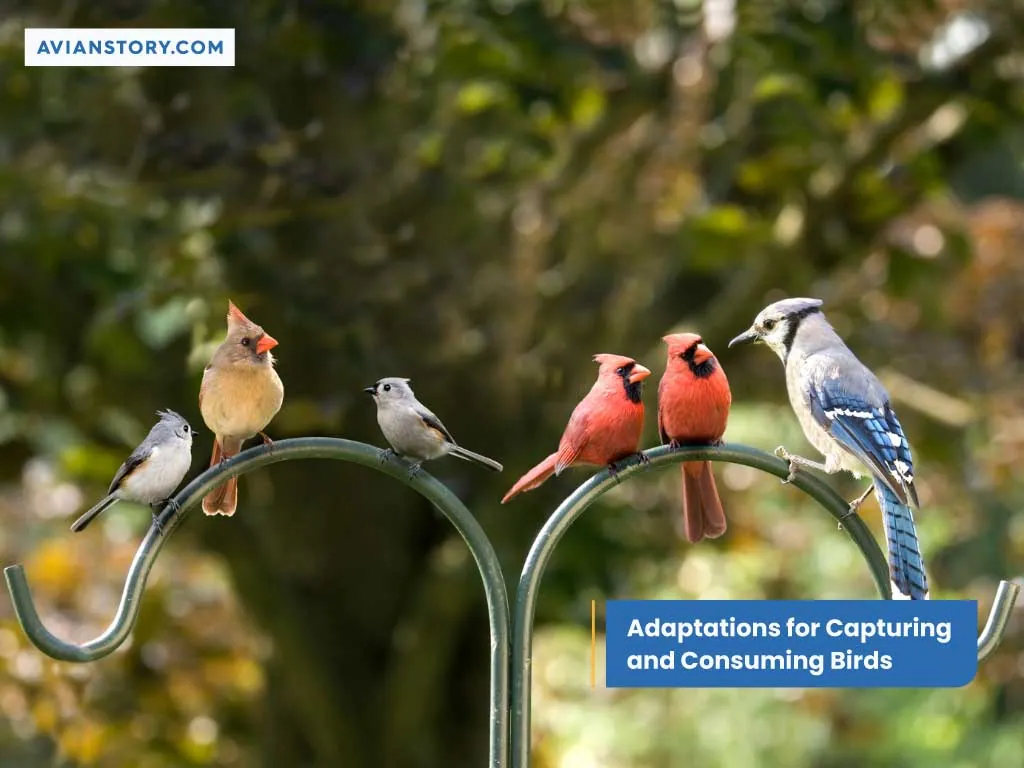
Hawks possess physical and behavioral adaptations that enable them to capture and consume birds with minimal effort. Check them out.
Physical Adaptations
These physical adaptations make all hawk species highly efficient at capturing and consuming birds.
Talons
Hawks have large and powerful claws to allow for a solid and secure grip on the prey. The tip of the talons is also as sharp as a dagger for ease of penetrating the prey’s body.
Beak
Like all raptors, hawks boast a curved beak with a sharp hooked edge for tearing apart the prey when consuming it.
Vision
Hawk’s eyes are on the front of its face. This enables it to focus both eyes on a single object. On top of that, a hawk’s fovea contains about 400,000 cones per square millimeter. This is twice that of humans. As such, they can see finer details than humans, including small bird prey from miles away.
Flight Agility
Hawk’s wings are long, broad, and pointed but with a narrow base for maximum flight agility. The design of the wings enables these raptors to make tight maneuvers in confined spaces with minimal effort.
Behavioral Adaptations
In addition to the physical adaptations, these predatory birds have also developed diverse behavioral adaptations. Here are a few examples:
Stealth and Surprise
Hawks can stay undetected for a long time by the prey. This enables them to swoop down and catch the prey by surprise.
Camouflage
The coloration of hawks, which is mainly dark and medium brown, helps them blend smoothly into their surroundings. This makes it difficult for them to be detected, allowing them to watch and listen for prey.
Patience
Hawks may wait patiently in a hidden spot or on a branch without moving. They usually do this until potential bird prey comes within range, and they ambush it.
Impact of Bird Predation on Ecosystems
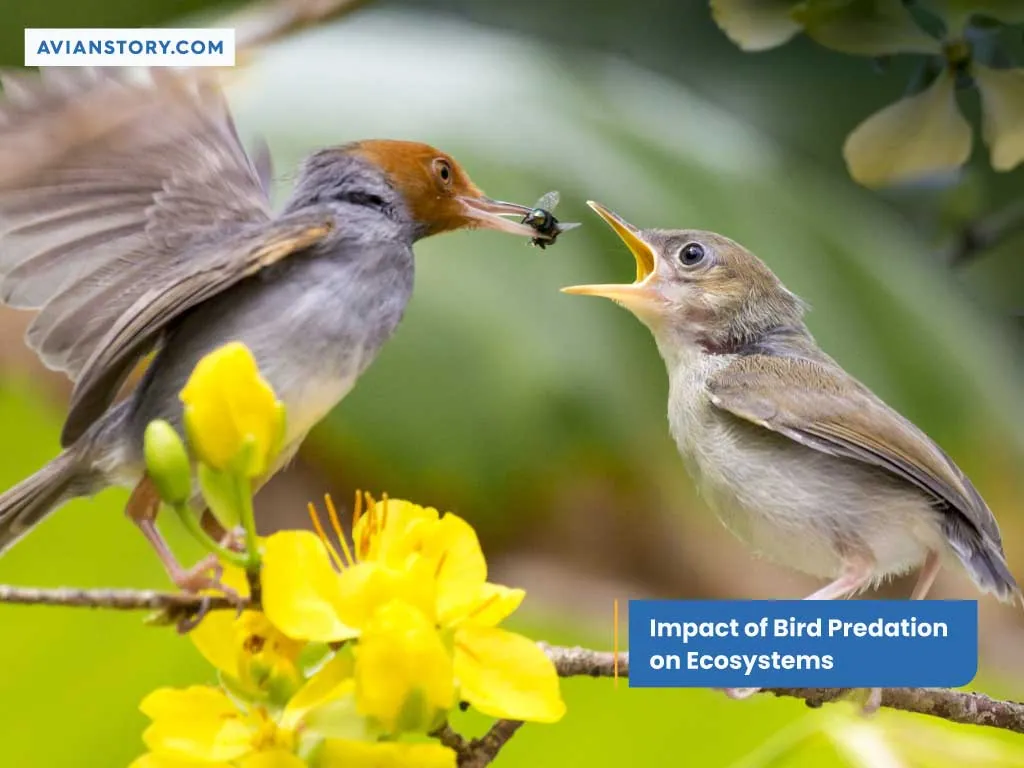
Bird predation may have significant effects on ecosystems in many ways. These include:
Population Control of Prey Species
Predatory birds like hawks may help control the population size of bird prey. This helps prevent ecological damage associated with overpopulation.
Effects on Bird Community Structure
Additionally, bird predation may affect the bird community structure, affecting the prey’s distribution, diversity, and abundance. This happens when the bird’s prey migrates, trying to avoid habitats where the predators are highly active.
Prey Switching Behavior
When predators switch from one prey to another based on prey availability, this may result in ecological stability in the ecosystems. This is because the behavior helps minimize the overexploitation of certain prey species.
Human Impact on Hawks’ Bird Predation
Several human activities may have compelling effects on hawks’ bird predation, such as:
Urbanization
Urbanization may lead to habitat destruction, causing a decline in prey populations. On a positive note, it may provide hawks with more urban bird prey like pigeons and sparrows.
Habitat Loss and Fragmentation
Habitat loss and fragmentation may reduce the wealth and diversity of prey available to hawks. Consequently, this may lead to growing competition and predation pressure from other raptors, reducing their hunting success.
Pollution and Pesticides
Pollution may lead to habitat degradation and loss, reducing prey diversity available to hawks. Conversely, pesticides may harm or kill prey species that are a primary food source for hawks like rodents. This may diminish prey availability.
Conservation Efforts
Conserving hawk’s prey is critical in ensuring the unceasing survival of hawks as apex predators in the ecosystem. Here are conservation efforts that may benefit hawk prey:
Restricting the Use of Rodenticides
Controlling the use of pesticides, such as rodenticides, may help protect the health of prey species like rats and mice. As a result, this ensures hawks have access to abundant food sources.
Habitat Restoration and Preservation
Additionally, preserving and restoring habitats that prey species rely on helps maintain healthy prey populations. This helps ensure hawks have enough food sources, increasing their populations.
Conclusion
Being predatory birds, hawks feed on an array of prey, including birds. Besides pigeons and doves, they also feed on passerines like sparrows, finches, and starlings.
Hawks also prey on game birds, waterfowl, and raptors, such as smaller hawk species and owls. With this in mind, it is worth noting that hawks use different hunting techniques to capture birds. They also have various adaptations for catching bird prey, which increases their hunting success.
But guess what? Bird predation has significant effects on ecosystems, such as regulating bird prey population size. Similarly, human activities like urbanization also affect bird predation. For this reason, implementing conservation efforts is key in protecting the populations of prey species and that of hawks.

